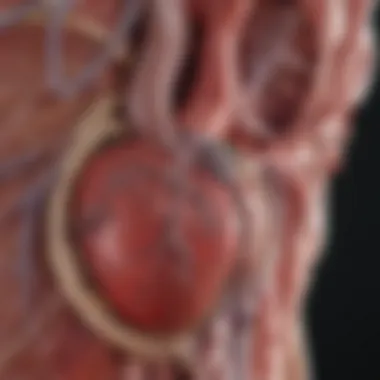Understanding Mortality in Heart Failure: Insights


Intro
Heart failure represents a significant health issue, affecting millions globally. Understanding the reasons behind mortality in individuals with this condition is vital. The progression of heart failure can be gradual but ultimately devastating. As symptoms worsen, various physiological changes occur in the body. Furthermore, social aspects can play a role in how patients experience their illness. An exploration of these mechanisms is necessary for providing comprehensive care.
In this article, we will examine key factors such as disease progression, complications, and the importance of psychosocial influences on end-of-life care. The role of palliative care will also be discussed, emphasizing a holistic approach to managing symptoms in heart failure patients.
Research Context
Background and Rationale
Understanding heart failure mortality involves a multi-faceted approach. Heart failure is often due to underlying conditions such as coronary artery disease or hypertension. These conditions lead to structural changes in the heart, impacting its ability to pump blood effectively. Over time, these changes can result in serious complications, including arrhythmias, kidney dysfunction, and even sudden cardiac death.
The importance of understanding these mechanisms cannot be overstated. Insights into mortality risk can guide treatment strategies. It can also help in developing patient-centered care approaches to improve quality of life in individuals facing this chronic condition.
Literature Review
Several studies have explored the prognosis of patients with heart failure. Research often highlights the correlation between the severity of heart failure and mortality rates. For example, one study emphasizes that patients with a low ejection fraction face a higher risk of mortality.
Additionally, psychosocial factors cannot be overlooked. Depression and anxiety often accompany heart failure, influencing both physical symptoms and overall mortality. A thorough review of existing literature reveals consistent themes surrounding the importance of comprehensive care, including physical and mental health support.
"Incorporating psychosocial considerations into treatment plans for heart failure patients can significantly improve their quality of life and possibly extend survival."
Methodology
Research Design
A mixed-methods approach is suitable for analyzing heart failure mortality. Quantitative data, such as patient demographics and clinical measures, could be combined with qualitative insights about patients' experiences and perceptions. This design aids in capturing the full spectrum of the heart failure experience.
Data Collection Methods
Data can be gathered through various means. One could use clinical databases to extract mortality rates associated with different heart failure stages. Surveys or interviews can also provide valuable context about patients' experiences, especially concerning their mental health and coping strategies.
As this article develops, we will further unpack the nuances of heart failure mortality, aiming to enrich the reader’s understanding of this complex issue.
Overview of Heart Failure
Heart failure is a complex medical condition affecting millions of people globally. It arises from the heart's inability to pump blood efficiently, leading to a cascade of physiological effects on the body. Understanding heart failure is crucial, as it provides insight into the processes that lead to mortality in affected individuals.
Definition and Types of Heart Failure
Heart failure can be generally defined as a syndrome where the heart's functional capacity is reduced. This leads to inadequate perfusion of tissues and organs. It is categorized mainly into two types:
- Systolic Heart Failure: This occurs when the heart muscle does not contract effectively, leading to reduced ejection fraction.
- Diastolic Heart Failure: This happens when the heart muscle becomes stiff and does not relax properly, causing impaired filling of the heart chambers.
In clinical settings, both types can coexist, complicating the patient's presentation and management.
Prevalence and Demographics
The prevalence of heart failure is significantly rising, largely due to an aging population and increased survival rates from heart diseases. It is estimated that over 26 million people worldwide suffer from heart failure, impacting diverse demographics.
Patients over the age of 65 are particularly vulnerable, but heart failure can also be seen in younger individuals, especially those with underlying conditions like hypertension or diabetes. The incidence and outcomes of heart failure vary across gender, ethnicity, and geographic locations. Understanding these patterns helps in tailoring treatment and preventive strategies.


"Heart failure affects diverse groups, making its implications not just medical but also societal."
In summary, the overview of heart failure serves as a foundational element in this article. It sets the stage for further discussions on the pathophysiology, common causes, symptoms, and ultimately, the mortality ramifications associated with this chronic disease.
Pathophysiology of Heart Failure
Understanding the pathophysiology of heart failure is crucial for comprehending how the disease progresses and affects mortality. The heart's function is to pump blood efficiently throughout the body. When this function deteriorates, it leads to a series of complex physiological events and compensatory mechanisms that influence patient outcomes. This section aims to elucidate the underlying mechanisms of cardiac function and the compensatory processes that the body undertakes in response to heart failure.
Understanding Cardiac Function
Cardiac function is primarily dependent on the heart's ability to fill and eject blood effectively. It involves several key components such as myocardial contractility, heart rate, preload, and afterload. Each element plays a significant role in maintaining adequate circulation. In heart failure, the myocardium is damaged due to various factors, including myocardial infarction or chronic pressure overload. The reduced contractile strength leads to decreased cardiac output, which can trigger signs and symptoms associated with heart failure.
As cardiac output declines, the body perceives this insufficiency and initiates compensatory measures. These measures include the activation of neurohormonal pathways, particularly the renin-angiotensin-aldosterone system (RAAS) and sympathetic nervous system, in an attempt to enhance perfusion to vital organs.
Compensatory Mechanisms
In response to a compromised cardiac output, the body activates several compensatory mechanisms. These efforts are essential in the short term but can be detrimental over extended periods. Key compensatory mechanisms include:
- Neurohormonal Activation: This involves increased sympathetic nervous system activity, which raises heart rate and contractility. However, excessive stimulation can lead to further myocardial damage over time.
- Fluid Retention: The activation of the RAAS system leads to sodium and water retention, increasing blood volume. While this can temporarily help maintain blood pressure, prolonged retention exacerbates congestion and worsens heart failure symptoms.
- Cardiac Remodeling: Over time, the heart undergoes structural changes, such as hypertrophy or dilation, which can initially help improve function. However, these alterations eventually contribute to further functional decline.
These compensatory responses may delay the onset of overt symptoms, but they rarely address the underlying cardiac dysfunction. Eventually, they can lead to worsening heart failure and increased mortality risk.
“Understanding these compensatory mechanisms is essential for developing targeted therapeutic strategies that can improve mortality outcomes in heart failure patients.”
In summary, the pathophysiology of heart failure encompasses an intricate interplay of cardiac functioning and compensatory responses. Grasping these concepts is vital for healthcare professionals and researchers aiming to mitigate mortality risks related to heart failure.
Progression of Heart Failure
The progression of heart failure is a critical aspect of understanding mortality in patients affected by this condition. Recognizing how heart failure advances helps medical professionals plan effective treatment strategies and provides insight into patients' expected outcomes. The journey of heart failure typically unfolds in stages, and each stage carries distinct physiological and symptomatic changes that could lead to complications and eventual death. Effective management relies on timely recognition of these stages and the symptoms that arise as the condition deteriorates.
Stages of Heart Failure
Heart failure is commonly classified into stages that reflect the severity and progression of the disease. The New York Heart Association (NYHA) classification is widely used to categorize these stages:
- Stage I: No limitations on normal physical activity. Patients may have no symptoms but may be at risk due to underlying issues.
- Stage II: Mild limitations exist, with symptoms occurring during physical activity, though comfortable at rest.
- Stage III: Marked limitations. Symptoms present even with minimal effort and patients are comfortable only at rest.
- Stage IV: Severe limitations. Symptoms are present even at rest, and any physical activity increases discomfort.
Each stage reflects not just the physical capacity of the patient but also the underlying changes in cardiac function. As the stages progress, the risk of mortality increases primarily due to complications such as sudden cardiac arrest or exacerbation of heart failure symptoms. It is crucial for healthcare providers to monitor patients closely during these stages to better anticipate changes and decide on appropriate interventions.
Symptoms and Their Deterioration
As heart failure advances, the spectrum of symptoms widens. Initially, fatigue and shortness of breath may be manageable. However, as the stages progress, symptoms can deteriorate significantly, affecting quality of life and increasing mortality risk. Common symptoms include:
- Dyspnea: Shortness of breath during activity or at rest.
- Decreased exercise tolerance: Patients may find simple tasks challenging.
- Fluid retention: Resulting in swelling in legs, ankles, or abdomen.
- Rapid or irregular heartbeat: Palpitations can escalate, indicating worsening heart condition.
Deterioration is not just about physical symptoms. Psychological impacts such as anxiety and depression are prevalent, compounding the experience of heart failure. This interconnectedness of physical and emotional health further complicates patient management and encourages a comprehensive approach to care.
Observational studies suggest that there is a strong relationship between symptom management and quality of life. Addressing symptoms through timely medical interventions can significantly impact the overall well-being of patients.
Common Causes of Death in Heart Failure
Understanding the common causes of death in heart failure is essential for grasping the broader implications of the disease. It serves as a critical intersection between clinical practice and patient care. By dissecting the primary causes of mortality, healthcare professionals can better tailor their approaches to management and intervention. This section will outline the main factors contributing to death, which often overlap and compound the disease's severity.


Cardiac Events
Sudden Cardiac Arrest
Sudden cardiac arrest is a notable cause of death in heart failure patients. This phenomenon occurs when the heart suddenly stops beating, which leads to an abrupt loss of blood flow to the brain and other organs. The key characteristic of sudden cardiac arrest is its unpredictability. It can happen without warning, making it a severe concern for heart failure patients. Its inclusion in this article is crucial due to its potential to happen at any stage of heart failure. The unique aspect of sudden cardiac arrest is its rapid onset, demanding immediate medical intervention for survival. This situation underscores the ongoing need for effective monitoring and management strategies.
Heart Attack
Heart attack, or myocardial infarction, is another common cause of death among those with heart failure. It occurs when the blood supply to a part of the heart is severely reduced or blocked. The main characteristic of a heart attack is its association with underlying coronary artery disease, which is prevalent in heart failure patients. This factor makes it a significant topic for discussion in this article. The unique feature of heart attacks is their potential to cause lasting damage to heart muscle, thereby exacerbating heart failure. Understanding heart attacks in this context illuminates how they can lead to further deterioration in heart failure patients.
Progressive Heart Failure Symptoms
Congestive Symptoms
Congestive symptoms are common in patients experiencing progressive heart failure. These symptoms include swelling in the extremities, shortness of breath, and fatigue. Such symptoms are critical because they indicate fluid buildup, which can signal worsening heart function. The characteristic of congestive symptoms lies in the systemic effects they have on patient quality of life. Their inclusion in this article is vital, as recognizing these signs can lead to timely interventions. The unique aspect of congestive symptoms is that they often require a multifaceted approach to management, incorporating both medication and lifestyle changes. This complexity can either benefit or hinder patients depending on how well their conditions are managed.
Clinical Decline
Clinical decline refers to the gradual deterioration of health status in heart failure patients. This aspect reflects the cumulative effects of heart failure on functional capacity and overall health. A key characteristic of clinical decline is the gradual nature of its symptoms. This slow progression poses challenges for caregivers and healthcare providers alike. It takes a nuanced understanding of patient needs to address clinical decline effectively. In this article, discussing clinical decline is important because it underlines the importance of ongoing assessment and intervention. The unique feature is that it often signals a phase of needing palliative care, marking a critical point in the treatment pathway.
Associated Comorbidities
Chronic Kidney Disease
Chronic kidney disease frequently coexists with heart failure and significantly contributes to mortality. The connection between the kidneys and heart is well established; poor kidney function can exacerbate heart failure symptoms. A key characteristic of chronic kidney disease is its potential to worsen fluid balance issues. Including this discussion adds depth to the article, highlighting the intricate relationships among bodily systems. The unique aspect of chronic kidney disease in heart failure is the feedback loop it creates, where declining kidney function further impairs cardiac health. This interplay is crucial for developing effective treatment plans.
Diabetes
Diabetes is another prevalent comorbidity in heart failure patients, with significant implications for mortality. The relationship between diabetes and heart failure increases the risk of cardiovascular events. A key characteristic of diabetes is its impact on blood sugar regulation and vascular health. This topic is beneficial for this article as it illustrates the systemic nature of heart failure complications. The unique aspect of diabetes is that it can lead to complications affecting both heart and kidney function, making it doubly challenging. Understanding this relationship is vital for creating comprehensive care strategies.
Psychosocial Aspects of Heart Failure and Death
Heart failure does not only impact the physical health of patients; it also profoundly affects their psychological well-being and social dynamics. Understanding these psychosocial aspects is critical for healthcare professionals and family members. This section will delve into the complex emotional landscape that exists alongside heart failure, examining how psychological factors influence patient experiences and outcomes.
Psychological Impact on Patients
Anxiety and Depression
Anxiety and depression are prevalent among heart failure patients. These mental health conditions can exacerbate physical symptoms, leading to a vicious cycle that further deteriorates health. Anxiety about symptoms, treatment, and overall prognosis often intersects with feelings of hopelessness that can arise from living with a chronic condition. The key characteristic of anxiety and depression is their ability to amplify perceptions of illness severity, thereby making day-to-day life more burdensome for patients. Understanding this nexus is essential, as it enables healthcare providers to tailor interventions that address both mental and physical health simultaneously.
The unique feature of managing anxiety and depression in heart failure patients is the holistic approach required. Integrating mental health support with standard medical care can enhance patients’ quality of life. Addressing emotional turmoil not only alleviates distress but can potentially improve adherence to treatment plans and overall health outcomes.
Quality of Life Considerations
Quality of life is a crucial aspect in the context of heart failure. It refers to the general well-being of patients, encompassing physical, emotional, and social dimensions of health. Poor quality of life can significantly reduce motivation for treatment and self-care, further complicating the management of heart failure. The key characteristic of quality of life considerations lies in their multidimensional nature; they cannot be assessed solely through physical metrics.
In this article, focusing on quality of life is a beneficial choice because it emphasizes the need for patient-centered care. Understanding which factors reduce quality of life can guide healthcare providers in creating more effective management strategies.
The unique feature of this consideration is that improvements in quality of life can lead to reductions in hospitalizations and healthcare costs, illustrating the practical benefits of addressing psychosocial elements. Assessing and enhancing quality of life offers advantages such as better patient engagement and improved clinical outcomes.
Family and Caregiver Dynamics


Family and caregivers play a pivotal role in the management of heart failure. Their involvement can greatly influence the patient’s emotional state and adherence to treatment. Family members often grapple with their own emotions, including stress and anxiety related to the patient's condition. The dynamics within the care network can also affect how the patient copes with their illness. Effective communication and shared decision-making can enhance the emotional support provided to patients, promoting a more collaborative approach to care.
"The role of family extends beyond simply providing physical care; it encompasses emotional and psychological support that is crucial for patient resilience."
Understanding these dynamics can help in developing strategies that promote a supportive environment for heart failure patients. Programs that include family members in discussions about treatment and care can lead to better outcomes, as all parties feel empowered to make decisions.
Role of Palliative Care
Palliative care plays a critical role in the management of heart failure. It focuses on providing relief from the symptoms and stress of the disease, irrespective of the diagnosis stage. The ultimate goal is improving the quality of life for patients and their families. This aspect becomes especially significant considering the multifaceted nature of heart failure, where physical symptoms intertwine with emotional and psychosocial challenges.
One key benefit of palliative care is that it aligns the treatment plan with the patient’s goals and preferences. In heart failure, where the prognosis can often be uncertain, having open discussions about preferences and care objectives allows for more personalized care. Moreover, palliative care teams provide comprehensive support, encompassing physical, emotional, and spiritual needs of patients. This holistic approach delivers not just medical help but also facilitates better communication among caregivers and families.
Palliative vs. Curative Care
Palliative care differs fundamentally from curative care. While curative care concentrates on treating the disease itself with the aim of achieving a full recovery, palliative care aims to alleviate suffering without necessarily seeking to cure the disease. For heart failure patients, the distinction is important. Many patients may face advanced stages where curative options are limited or no longer effective.
This does not imply abandoning all medical intervention. Instead, palliative care can be integrated with ongoing treatments aimed at managing heart failure symptoms. The advantage of this approach is notable: it allows medical professionals to focus on what is most important to patients, which often includes pain relief, emotional support, and maintaining dignity. This dual-focused care model can enhance patient experience and provide a more meaningful approach to treatment.
Symptom Management
Effective symptom management is a cornerstone of palliative care in heart failure. This includes addressing various symptoms such as dyspnea, fatigue, and depression, which can greatly affect patients’ well-being. Managing these symptoms not only improves quality of life but also supports patients in coping with their illness more effectively.
Pain Management
Pain management is a critical component in the overall symptom management strategy. In heart failure, pain can arise from congestive symptoms or deconditioning. Addressing this pain is importent, as uncontrolled pain can lead to increased distress and decreased functionality.
Pain management strategies may include medications such as opioids for severe pain, or non-opioid analgesics for milder discomfort. A tailored approach ensures that the chosen methods align with the individual's specific needs and preferences. The unique feature of pain management in palliative care is its adaptability. As symptoms change, so can the management strategies, ensuring sustained relief.
While beneficial, pain management must be approached cautiously. The risk of dependency on certain medications, especially opioids, remains a concern. Therefore, continuous evaluation and monitoring are vital to balance effective pain relief and safety.
End-of-Life Decisions
End-of-life decisions in the context of heart failure are essential but often challenging. These decisions encompass a broad array of issues—from choice of treatment to preferences for end-of-life care. Integrating palliative care facilitates these conversations and helps patients and families voice their wishes.
A key characteristic of end-of-life decisions is that they empower patients. Through discussions with healthcare professionals and the palliative team, patients can determine the kind of care they wish to receive. This empowerment can be particularly beneficial in minimizing distress and ensuring comfort at the final stages of life.
However, navigating through these decisions can be complex. Ethical dilemmas may arise, and the emotional weight of such choices can be overwhelming. This is where palliative care can provide support. By focusing on communication and understanding, palliative care helps guide families through these profound moments, ensuring that decisions made truly reflect the wishes of the patient.
In summary, the role of palliative care in heart failure is to enhance quality of life and support patients and families through difficult conversations and experiences. The integration of palliative care within heart failure management reflects a shifting perspective towards a more patient-centered approach that values quality over quantity of life.
Future Directions in Heart Failure Research
The landscape of heart failure research is evolving. Understanding the mortality associated with this condition requires not only comprehending its progression but also exploring innovative approaches that could potentially change outcomes. These explorations promise to provide insights that will shape current and future treatment methodologies.
Innovations in Treatment Approaches
New treatment modalities are constantly emerging in the field of heart failure. These innovations often focus on improving both the quality and quantity of life for patients.
- Advanced Medical Therapies: Medications such as SGLT2 inhibitors are showing promising results in reducing mortality rates. These treatments help in managing blood sugar levels and offer cardiovascular benefits, thus making them a crucial addition to heart failure management.
- Device Therapies: Technologies like implantable cardioverter defibrillators (ICDs) and cardiac resynchronization therapy (CRT) are enhancing outcomes for many patients. These devices can prevent fatal arrhythmias, making them essential in managing severe heart failure cases.
- Gene Therapy: Although still in experimental stages, gene therapy holds potential for treating the underlying causes of heart failure. Altering genetic pathways could lead to improved heart function and reduced need for extensive interventions.
The inclusion of these innovations into everyday clinical practice can revolutionize the treatment landscape of heart failure. However, comprehensive evaluation of their long-term effects is necessary.
Research on End-of-Life Care
As heart failure progresses, patients often confront end-of-life decisions. Research focused on end-of-life care aims to provide a framework for better management of symptoms and improve the overall experience for patients and their families.
- Palliative Care Integration: Research advocates for early integration of palliative care in the management of heart failure. This approach prioritizes symptom relief and psychological support, making a significant difference in patient well-being.
- Advance Care Planning: Understanding the preferences of patients regarding end-of-life decisions is crucial. Studies indicate that when patients engage in advance care planning, their wishes are more likely to be honored, leading to less distress during the dying process.
- Family Dynamics: It's important to assess how family involvement impacts end-of-life care. Engaging families in care decisions often fosters a supportive environment that can enhance the quality of end-of-life experiences for patients.
"Transformative research on end-of-life care can change the way we think about managing mortality in heart failure, emphasizing dignity and comfort."



